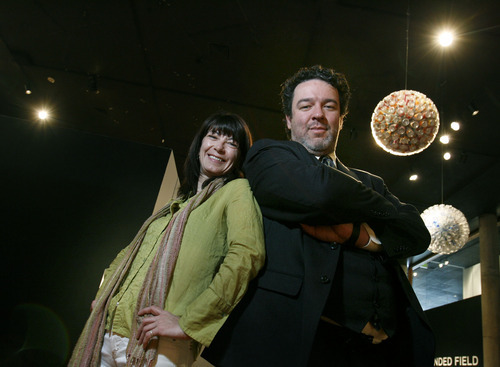This is an archived article that was published on sltrib.com in 2011, and information in the article may be outdated. It is provided only for personal research purposes and may not be reprinted.
After years of struggling to find an audience, the Salt Lake Art Center is seeing a dramatic surge in visitors under Adam Price, its latest executive director.
Supporters of the art center have long believed its downtown location on 20 S. West Temple is a problem because it's not near the kind of urban amenities open during the day and on weekends — bookstores, coffee shops, restaurants, libraries and college campuses — that usually share traffic with an art museum.
"Obviously, having a hole in the ground across the street from us for the past five years has been a detriment," says Salt Lake Art Center board member Josh Kanter, referring to the ongoing City Creek construction project that has turned downtown Salt Lake City into a construction zone. "Getting a walk-in audience is very difficult."
So it came as a pleasant surprise to the center's supporters when the most recent financial report found that the number of visitors to the museum's exhibitions has nearly tripled over the past year. Through the past decade, about 20,000 people visited the art center annually, but during 2010 that number jumped to 68,000. Price is hoping for 80,000 before the end of 2011.
Price, 42, took control of the center in January 2010. His "favorite number" in the new report is 74 percent — the decline in the center's average cost per visitor during 2010. Dropping from roughly $48 to $12.50 per visitor, it's one of the lowest rates for an art museum in the nation.
"That's astounding," Kanter says.
As another indicator of public support, the art center's membership has jumped from 61 at the end of 2009 to around 1,200 by the close of 2010.
Price attributes the surge of interest in part to the art center's programs, but also to an upswing in interest in contemporary art statewide in the past couple years. The Utah Museum of Fine Arts at the University of Utah and Brigham Young Museum of Art both have added full-time contemporary art curators, while Ephraim's Central Utah Art Center has also been emphasizing contemporary art.
Trends aside, Kanter and others in the local art community attribute the art center's gains almost entirely to Price, a former lawyer who made a splash on the art scene with his 337 Project. In what became a community event in 2006, 150 local artists transformed an office building into a contemporary art exhibit before it was demolished in the spring of 2008.
"Adam's doing the right things to make contemporary art accessible," Kantor says. "Once you make it accessible, people come back."
In the past year and a half, the art center has offered contemporary art in the guise of a miniature golf course, in a digital show through a partnership with the Sundance Film Festival and at an exhibit of Utah culture icons made from bread dough.
As the City Creek development comes online in the next few years, the art center's downtown location should become a positive for its future. Even so, Price sees the future of contemporary art in Utah outside of the confines of a museum.
"The most important part of the new curatorial vision is not being bound by four walls," he says. "One thing contemporary art can do is engage the community where people really work and play."
gwarchol@sltrib.com facebook.com/tribremix —
By the numbers
244 percent • Attendance increase, 2009 to 2010
61 • Number of Art Center members on Jan. 1, 2010
1,251 • Number of members on May 1, 2011
40 percent • Increase in number of donors from 2009 to 2010
153 percent • Increase in dollars received through year-end appeal, from 2009 to 2010
3 • Number of galleries on Jan. 1, 2010
6 • Number of galleries expected by end of 2011
9 • Number of exhibitions per year, 2008 to 2009
19 • Number of exhibitions projected for 2011
74 percent • Decline in the average cost per visitor from 2009 to 2010



